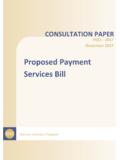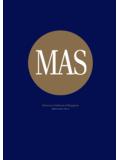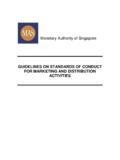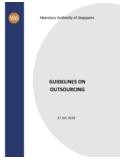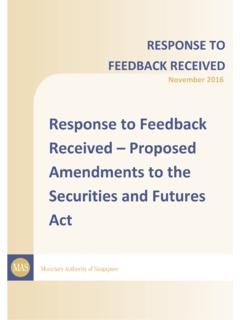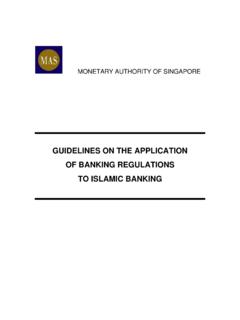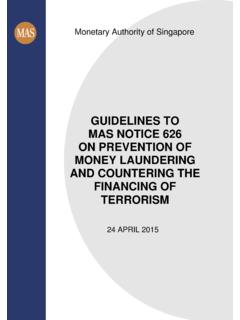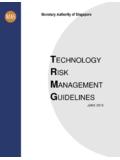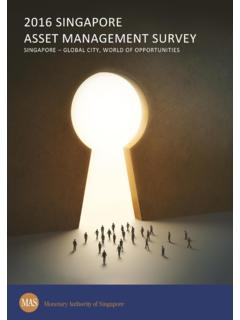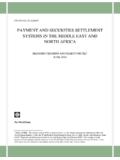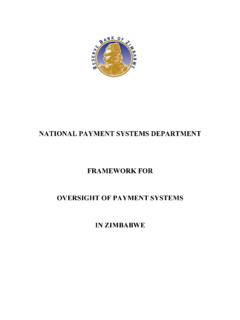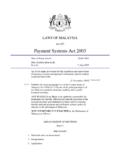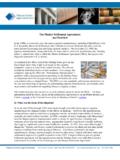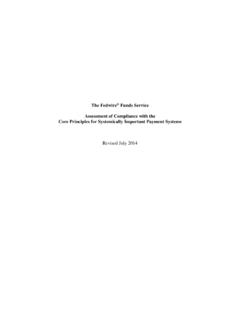Transcription of FOREIGN EXCHANGE SETTLEMENT RISK …
1 FOREIGN EXCHANGE SETTLEMENT RISK. practices IN singapore . July 2001. Market Infrastructure and Risk Advisory Department Monetary Authority of singapore FOREIGN EXCHANGE SETTLEMENT RISK. practices IN singapore . MARKET INFRASTRUCTURE & RISK ADVISORY DEPARTMENT. MONETARY AUTHORITY OF singapore . JULY 2001. THE MONETARY AUTHORITY OF singapore . CONTENTS PAGE. EXECUTIVE SUMMARY .. i 1 INTRODUCTION .. 1. Background .. 1. International Initiatives in the Reduction of FOREIGN EXCHANGE SETTLEMENT 1. East Asia Pacific Initiatives in the Reduction of FOREIGN EXCHANGE SETTLEMENT 2. 2. Raising Awareness .. 3. Understanding Current 3. Promoting 3. Outline of 4. 2 FOREIGN EXCHANGE SETTLEMENT RISK .. 5. SETTLEMENT Risk in FOREIGN EXCHANGE 5. How SETTLEMENT Risk 5. Consequences of a Failed Transaction .. 5. Central Bank Concerns .. 6. Duration and Magnitude of Exposures .. 6. Defining and Measuring FOREIGN EXCHANGE SETTLEMENT 7. Defining FOREIGN EXCHANGE SETTLEMENT 7.
2 Measuring FOREIGN EXCHANGE SETTLEMENT 8. Changing Status of a Trade .. 9. Minimum and Maximum Exposures ..10. Market Infrastructure & Risk Advisory Department, Monetary Authority of singapore b 3 SETTLEMENT practices IN THE singapore FOREIGN . EXCHANGE MARKET .. 12. Survey Methodology ..12. Scope ..12. Sample Data SETTLEMENT practices ..13. SETTLEMENT Methods ..13. Key Times in the SETTLEMENT Process ..15. SETTLEMENT Duration of Exposures for Currency Pairs ..17. Industry Risk A. The One-Day Industry B. The Inter-day Industry Profile ..20. Variation Among Reporting Banks ..21. A. Current best B. Current worst practice ..22. C. Industry Distribution Analysis ..24. Caveat ..25. 4 Risk Management .. 27. Best Practice in Institutions ..27. Senior Management Measurement of Exposures ..27. Control of Reducing FOREIGN EXCHANGE SETTLEMENT Risk ..29. Netting ..29. Improved Cancellation and Reconciliation Times ..30. Real-Time Gross SETTLEMENT .
3 30. Continuous Linked SETTLEMENT (CLS) ..31. Market Infrastructure & Risk Advisory Department, Monetary Authority of singapore c Payment versus Payment (PvP) ..32. Longer Payment System Operating Hours ..32. Contracts for Difference (CFD)..33. 5 Conclusions .. 34. Summary of Recommendations ..35. Appendix 1: Case Studies ..36. Appendix 2: Sample Questionnaire ..40. Appendix 3: Currency Codes ..49. Appendix 4: References ..50. Market Infrastructure & Risk Advisory Department, Monetary Authority of singapore d LIST OF TABLES. Table 1: Status of FOREIGN EXCHANGE 8. Table 2: Currencies Traded and SETTLEMENT Methods Used ..14. Table 3: Documentation of Cancellation Deadlines ..15. Table 4: Cancellation Deadlines and Reconciliation Times ..16. Table 5: Industry Weighted Average Duration of Exposures (Hours) ..17. Table 6: Number of Counterparties for Bilateral Netting ..30. LIST OF FIGURES. Figure 1: FOREIGN EXCHANGE SETTLEMENT Process : Changing Status of a Trade.
4 10. Figure 2: Single Day Profile ..18. Figure 3: Single and Inter-day Profiles ..20. Figure 4: Single Day Profile - Best, Current and Worst Figure 5: Best Practice Single and Inter-day Figure 6: Worst Practice Single and Inter-day Figure 7: Distribution Analysis Exposure Period and Adjusted Average Exposure ..24. Figure 8: Distribution Analysis Exposure Period and Adjusted Peak Exposure ..25. Market Infrastructure & Risk Advisory Department, Monetary Authority of singapore i EXECUTIVE SUMMARY. Trading in FOREIGN EXCHANGE markets involves the management of many risks , including liquidity risk, EXCHANGE rate (market) risk and operational risk. However, one of the largest risks facing FOREIGN EXCHANGE participants is SETTLEMENT risk. SETTLEMENT risk arises because the two legs of a FOREIGN EXCHANGE transaction are delivered in different countries, often in different time zones. However, while time zone differences are an important determinant, studies have shown that FOREIGN EXCHANGE SETTLEMENT risk is more than an intra-day phenomenon.
5 This exposure lasts from the time a payment instruction for the currency sold can no longer be cancelled unilaterally until the time the currency purchased is received with finality. This report presents the results of a survey conducted by the Monetary Authority of singapore (MAS) on the SETTLEMENT practices of major participants in the singapore FOREIGN EXCHANGE market. The survey results indicate that many institutions tend to have significant exposures across their books. Bilateral netting is also not widely practiced by the surveyed banks. While the value at risk is a natural consequence of trading, the length of time that banks are exposed is of particular concern. The survey found that the industry's exposure for a single day's trades tends to last in excess of 24 hours resulting in the accumulation of exposure over two days. Current reconciliation practices and unfavourable cancellation deadlines have contributed to the excessive exposure.
6 In terms of risk management practices , the survey found that the majority of the banks tend to under-estimate their value at risk by using the single calendar day method to gauge their exposures. While several institutions surveyed are acutely aware of their exposure to FOREIGN EXCHANGE SETTLEMENT risk and have plans to reduce and improve their risk management Market Infrastructure & Risk Advisory Department, Monetary Authority of singapore ii practices , there are still some which are not actively addressing the issue. The need for institutions to improve their focus on FOREIGN EXCHANGE SETTLEMENT risk management is further illustrated by the survey's findings that around one-third of the respondents did not have any senior management involved in the assessment of this risk. The MAS will encourage the industry to move towards international best practices and will consider undertaking a further study to monitor the progress in managing and reducing FOREIGN EXCHANGE SETTLEMENT risk.
7 Market Infrastructure & Risk Advisory Department, Monetary Authority of singapore 1. 1 INTRODUCTION. Background International Initiatives in the Reduction of FOREIGN EXCHANGE SETTLEMENT Risk In 1995, the central banks of G10 countries surveyed approximately 80. major banks in their respective local markets in order to document practices for settling FOREIGN EXCHANGE trades. The survey results were collated by the 1. Committee on Payment and SETTLEMENT Systems (CPSS) and the findings were published in a report, SETTLEMENT Risk in FOREIGN EXCHANGE Transactions, in 1996. This report is frequently referred to as the Allsopp Report. In addition to sharing the results of the survey of market practices , the report also explained how FOREIGN EXCHANGE SETTLEMENT risk arises and it set out a methodology for measuring FOREIGN EXCHANGE SETTLEMENT risk. The report also considered the options for tackling the problem and set out strategies to be adopted by the G10 central banks on the basis of these options.
8 In late 1997, the central banks of G10 countries carried out another survey of banks in the FOREIGN EXCHANGE market. The purpose was to measure the progress made by individual banks in meeting the Allsopp Report recommendations on prudential management and control of FOREIGN EXCHANGE SETTLEMENT risk. The results of their findings were published in the second document, Reducing FOREIGN EXCHANGE SETTLEMENT Risk: A Progress Report. This report is often referred to as the Progress Report. In summary, the report concluded that individual banks had made encouraging progress in managing their FOREIGN EXCHANGE SETTLEMENT exposures. 1. The CPSS was set up by the Group of Ten (G10) central banks in 1990 to act as a forum for monitoring and analysing payment and SETTLEMENT arrangements. The Secretariat for the CPSS is based at the Bank for International Settlements in Basel, Switzerland ( ). Market Infrastructure & Risk Advisory Department, Monetary Authority of singapore 2.
9 East Asia Pacific Initiatives in the Reduction of FOREIGN EXCHANGE SETTLEMENT Risk The need for initiatives to reduce FOREIGN EXCHANGE SETTLEMENT risk within the East Asia Pacific region, similar to the ones undertaken by G10. central banks, was mooted by the Reserve Bank of Australia (RBA) at the Working Group on Payment and SETTLEMENT Systems (WGPSS) meeting in October 1999. This working group meets under the auscpices of the Executive Meeting of East Asia and Pacific Central Banks (EMEAP). 2. Recognising the need for a coordinated EMEAP effort to address cross-currency SETTLEMENT risk, members agreed to explore this proposal further. At the EMEAP WGPSS meeting in March 2000, the participants finalised plans to study FOREIGN EXCHANGE SETTLEMENT risk in the region. Specifically, the members agreed to conduct a FOREIGN EXCHANGE SETTLEMENT risk survey, in their respective countries, to further understand SETTLEMENT risk practices .
10 The working group aims to produce a regional report covering the survey findings of all EMEAP members. Objectives According to the most recent Bank for International Settlements (BIS). Triennial Central Bank Survey of FOREIGN EXCHANGE and Derivatives Market Activity done in 1998, singapore is the world's fourth largest FOREIGN EXCHANGE trading center and the singapore Dollar (SGD) is among the top ten traded currencies in the world. Therefore, it is important for us to adopt a proactive approach in understanding the extent of our FOREIGN EXCHANGE SETTLEMENT risk exposures. In addition, singapore is one of the first few major financial markets to open each day and has a time zone difference ranging from 12 to 17 hours with that of the United States, whose currency is the one against 2. Established in 1991, EMEAP is a co-operative organisation of central banks and monetary authorities in the East Asia and Pacific region.
